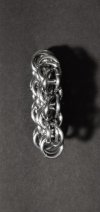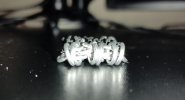Hello everyone. I was recently playing around with back to work and I ended up making what I think is a band/sheet variant of it. I was wondering if this has already been submitted and if it counts as a new idea. I have attached images to help.
You are using an out of date browser. It may not display this or other websites correctly.
You should upgrade or use an alternative browser.
You should upgrade or use an alternative browser.
Back to Work Band(Potential New Weave)
- Thread starter moaatt
- Start date
Thank you for your reply. I do not see the similarity between gridlock sheet and what I have posted. I will try to explain my understanding of the difference below(sorry for the ms paint tier images, I have yet to learn blender).
Looking at gridlock what I see for each vertical ring is something like this:
Where each vertical ring has 4 rings going through it at two height levels(top and bottom) with the rings at the top and bottom going through different rings than their counterparts on the opposite height level.
However for what I propose it has the following structure for its vertical rings:
Where each vertical ring has 6 rings going through it at 3 distinct height levels(top, middle, and bottom), where the rings at the top and bottom(blue rings) go through the same rings as their left/right counterpart on the other height level while the middle rings connect to rings other than the ones the blue ones connect to.
I hope that this provides clarity to the structure of what I made, though I am still open to discussion if this is just a variant of something else.
Looks like my text didn't make it. oh well.
I don't see the third layer in the image.
I don't see how it's not similar to gridlock? What you describe is just gridlock with an extra layer. While I wouldn't regard it as a new weave, I believe both chainmaillers.com
and
C
_CMB_
would.
chainmaillers.com
and
C
_CMB_
would.
Further reading:

 www.mailleartisans.org
www.mailleartisans.org

 www.mailleartisans.org
www.mailleartisans.org
I don't see the third layer in the image.
I don't see how it's not similar to gridlock? What you describe is just gridlock with an extra layer. While I wouldn't regard it as a new weave, I believe both
Further reading:

M.A.I.L. - Maille Artisans International League - Weave Info
 www.mailleartisans.org
www.mailleartisans.org

M.A.I.L. - Maille Artisans International League - Weave Info
 www.mailleartisans.org
www.mailleartisans.org
Looks like my text didn't make it. oh well.
I don't see the third layer in the image.
I don't see how it's not similar to gridlock? What you describe is just gridlock with an extra layer. While I wouldn't regard it as a new weave, I believe bothchainmaillers.com and C _CMB_ would.
Further reading:

M.A.I.L. - Maille Artisans International League - Weave Info
www.mailleartisans.org

M.A.I.L. - Maille Artisans International League - Weave Info
www.mailleartisans.org
The bottom layer of the weave is hard to see, I highlighted each layer in the image below to try and make it easier to make out.
I do see the similarity to gridlock, however I don't see very much similarity to snake skin or dwarf mail(though I am not familiar with those.).
I made this as sheet expansion of Back To Work, so I am not sure if this would count as a new weave.
I really need to continue working on the most recent revision to the CCT primer, lol, but I can put some of the concepts in here.
This is a weird one as according to the entry on MAIL, Back to Work was supposed to be Harvest Moon. Now Karpeth
goes and brings Gridlock Sheet into it. Thanks Mats
Karpeth
goes and brings Gridlock Sheet into it. Thanks Mats 
First, we need to look at the cellular structures of each weave.
Back to Work is a translation of a tethered messed up portion of unconnected parallel rings from Harvest Moon.
This is the base cell of Back to Work:

That cell is then rotated and connected

and then that weave cell (the two of them together) are directly translated into the band form of Back to Work (this render is a rough draft, there are some collisions)

Now, one of the possible reasons for the overlap between the red rings is, according to the entry on MAIL, back to work is recommended at an AR of 4.0 while the recommended AR for Harvest Moon is 5.0
Harvest Moon is a completely different animal from Back to work with a completely different base cell
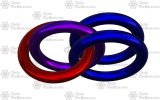
That cell is then rotated and connected
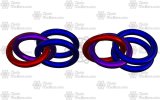
those 2 cells are then translated into the chain form of Harvest Moon

Then there's Gridlock whose base cell is this

That cell is then rotated and connected

and then those cells are translated to form (in this case) a band of gridlock
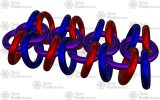
Based on that, is the weave you are trying to describe close to any of them?
This is a weird one as according to the entry on MAIL, Back to Work was supposed to be Harvest Moon. Now
First, we need to look at the cellular structures of each weave.
Back to Work is a translation of a tethered messed up portion of unconnected parallel rings from Harvest Moon.
This is the base cell of Back to Work:

That cell is then rotated and connected

and then that weave cell (the two of them together) are directly translated into the band form of Back to Work (this render is a rough draft, there are some collisions)

Now, one of the possible reasons for the overlap between the red rings is, according to the entry on MAIL, back to work is recommended at an AR of 4.0 while the recommended AR for Harvest Moon is 5.0
Harvest Moon is a completely different animal from Back to work with a completely different base cell

That cell is then rotated and connected

those 2 cells are then translated into the chain form of Harvest Moon

Then there's Gridlock whose base cell is this

That cell is then rotated and connected

and then those cells are translated to form (in this case) a band of gridlock

Based on that, is the weave you are trying to describe close to any of them?
What I tried to make is probably closest to back to work. Based on the classification mentioned here I would say this is two back to work bands with a sympathetic back to work chain between them.I really need to continue working on the most recent revision to the CCT primer, lol, but I can put some of the concepts in here.
This is a weird one as according to the entry on MAIL, Back to Work was supposed to be Harvest Moon. NowKarpeth goes and brings Gridlock Sheet into it. Thanks Mats
First, we need to look at the cellular structures of each weave.
Back to Work is a translation of a tethered messed up portion of unconnected parallel rings from Harvest Moon.
This is the base cell of Back to Work:
View attachment 6846
That cell is then rotated and connected
View attachment 6847
and then that weave cell (the two of them together) are directly translated into the band form of Back to Work (this render is a rough draft, there are some collisions)
View attachment 6848
Now, one of the possible reasons for the overlap between the red rings is, according to the entry on MAIL, back to work is recommended at an AR of 4.0 while the recommended AR for Harvest Moon is 5.0
Harvest Moon is a completely different animal from Back to work with a completely different base cell
View attachment 6852
That cell is then rotated and connected
View attachment 6853
those 2 cells are then translated into the chain form of Harvest Moon
View attachment 6854
Then there's Gridlock whose base cell is this
View attachment 6849
That cell is then rotated and connected
View attachment 6850
and then those cells are translated to form (in this case) a band of gridlock
View attachment 6851
Based on that, is the weave you are trying to describe close to any of them?
This is where we get to the part that is partially why Elfin band isn't up yet. Band forms are secondary weave forms as in most cases they they boil down to being terminated sheets and there are multiple ways to do this. These are 3 off the top of my head (all rough drafts and probably have collisions)What I tried to make is probably closest to back to work. Based on the classification mentioned here I would say this is two back to work bands with a sympathetic back to work chain between them.
First we have a direct translation with a single new yellow row of tethers

Next we have a reflective translation of the original band tethered by a new instance of orange and yellow rings (which are a direct translation of the blue and purple)

Finally we have a reflective translation with the terminal column of red rings (the ones going up the middle) as the symmetry line.

I'm sure I could come up with some others as well
out of the 4 options you presented this is the closest to what I made/envisioned. Though I made it in a way closer to taking the third option and doing it twice.
The main difference I see in options 2, 3, and 4 is just how the issue of ring overlap is handled. Is there any other important difference?
Also, I am not sure I would consider option 1 to be a band/sheet form of the weave as it would create sections in the end result that are clearly distinct from the indivudal chains of back to work.
Are sheets also secondary forms?Band forms are secondary weave forms as in most cases they they boil down to being terminated sheets and there are multiple ways to do this.
Can you post a flat profile picture facing the side where the vertical rings are?out of the 4 options you presented this is the closest to what I made/envisioned. Though I made it in a way closer to taking the third option and doing it twice.
IMO the ring overlap is what differentiates Back to Work from being an extension of Celtic segments.The main difference I see in options 2, 3, and 4 is just how the issue of ring overlap is handled. Is there any other important difference?
There are multiple ways to create sheets from chains, option 1 is probably, in the case of BtW, the second most basic way of doing so.Also, I am not sure I would consider option 1 to be a band/sheet form of the weave as it would create sections in the end result that are clearly distinct from the indivudal chains of back to work.
As of the current revision, there are 3 primary weave forms:Are sheets also secondary forms?
- Chains - extension along a single axis (e.g. Japanese 2 in 1)
- Sheets - extension along the first axis and expansion along the second axis (e.g. Japanese 4 in 1)
- 3D - extension along the first axis, expansion along the second axis, elevation along the third axis (e.g. Japanese 4 in 1 Cube)
- Bands
- Segments
- Units
- Radial
- Ouroborus
- ?
- Web Sheets (will possibly be renamed to Lattice Sheets)
Here is an image of what I made from the front, hopefully it will make things more clear. Also, sorry for the poor image quality, I didn't have the good camera available to take the picture.Can you post a flat profile picture facing the side where the vertical rings are?
Thank you for the reference to Celtic, it looks very similar to Back to Work (with the exception of having the overlap due to being made from smaller rings).IMO the ring overlap is what differentiates Back to Work from being an extension of Celtic segments.
Also looking at the construction of the item again I see that it is a bit of a hybrid of variants 2 and 4. I expect this happened as I did not consider the angle of the rings in response to overlap to be factor and thus I didn't make them consistent. If I were to remake it I would probably aim for the result of number 4 as it feels more consistent.
This is quite interesting if you wouldn't mind what is the most basic way to join them?There are multiple ways to create sheets from chains, option 1 is probably, in the case of BtW, the second most basic way of doing so.
Thank you for the explanation of the difference between secondary and primary forms. My goal was to design a sheet of back to work and I made the segment the size I did due to material and time constraints otherwise I would have made it larger. I guess my overall question is how can one showcase a new primary form using a physical medium? I was hoping that by showing a generalizable process of starting with a single back to work weave cell and showing how to extend it along the primary axis and expand it along the secondary axis that it could be considered a blueprint for a sheet(primary form) while physically being a band. I would appreciate any suggestions for how to best demonstrate sheets.These forms are considered to be secondary due to being portions of primary forms.
Attachments
I'm going to go a bit out of the original order of your post.

One of the premises of CCT is what I call the "Rule of Threes" and it has a lot to do with elements, transformations, and terminations. The simplest explanation of the concept is that "everything after three is in some way a repetition of what has come before". That explanation doesn't come close to all the parts that make it up, but it's what I have at this point For expansions, BtW is considered terminated, as an expansion, as without additional rings/cells it cannot connect to itself.
For expansions, BtW is considered terminated, as an expansion, as without additional rings/cells it cannot connect to itself.
I'm going to change the colors up a bit and break all 4 down into their respective elements
In number 1, we have 2 BtW bands tethered with elements from a single BtW band. In number 1, it's a single row of tether rings. In number 2, it's both rows of tether rings as well as the parallel rings.

In number 2, we have 2 reflective BtW bands tethered with elements from a single BtW band. In number 1, it's a single row of tether rings. In number 2, it's both rows of tether rings as well as the parallel rings.

In number 3, I created a reflection of an unterminated portion of BtW, using the terminating rings as a symmetry line.

In number 4, (which IMO would be actual BtW sheet) I took an unterminated portion of BtW and just kept directly translating it. It's the connections between the unterminated portions that then make BtW



That means that I should be able to take a carbon copy of the cell or patch, slide it along an axis and it will connect to the original.
You also need to note that in many cases just connecting carbon copies of existing chains will not work. There will also need to be AR changes to accommodate the additional connections present as a result of the expansion.
As an aside, both Back to Work and Elfin are most definitely not weaves I would choose to use to explain the foundations of CCT. I'll probably stick to something Japanese in the primer
This is quite interesting if you wouldn't mind what is the most basic way to join them?

This is where things get hard to explain and maybe a little confusing. It is part of the reason that I haven't published anything official about CCT yet.Also looking at the construction of the item again I see that it is a bit of a hybrid of variants 2 and 4. I expect this happened as I did not consider the angle of the rings in response to overlap to be factor and thus I didn't make them consistent. If I were to remake it I would probably aim for the result of number 4 as it feels more consistent.
One of the premises of CCT is what I call the "Rule of Threes" and it has a lot to do with elements, transformations, and terminations. The simplest explanation of the concept is that "everything after three is in some way a repetition of what has come before". That explanation doesn't come close to all the parts that make it up, but it's what I have at this point
I'm going to change the colors up a bit and break all 4 down into their respective elements
In number 1, we have 2 BtW bands tethered with elements from a single BtW band. In number 1, it's a single row of tether rings. In number 2, it's both rows of tether rings as well as the parallel rings.

In number 2, we have 2 reflective BtW bands tethered with elements from a single BtW band. In number 1, it's a single row of tether rings. In number 2, it's both rows of tether rings as well as the parallel rings.

In number 3, I created a reflection of an unterminated portion of BtW, using the terminating rings as a symmetry line.

In number 4, (which IMO would be actual BtW sheet) I took an unterminated portion of BtW and just kept directly translating it. It's the connections between the unterminated portions that then make BtW

What it looks like you did is take number 3, but expand in both directions from a BtW band.Also looking at the construction of the item again I see that it is a bit of a hybrid of variants 2 and 4. I expect this happened as I did not consider the angle of the rings in response to overlap to be factor and thus I didn't make them consistent. If I were to remake it I would probably aim for the result of number 4 as it feels more consistent.


That is a tough question to answer as "best" is subjective and will vary from person to person. The quick and dirty answer is that a weave cell for a sheet (which we call a weave patch) has to be at least 4 connected weave cells. Depending on transformations present in the sheet, that can potentially increase. Weave cells and patches must be directly translational.I guess my overall question is how can one showcase a new primary form using a physical medium? I was hoping that by showing a generalizable process of starting with a single back to work weave cell and showing how to extend it along the primary axis and expand it along the secondary axis that it could be considered a blueprint for a sheet(primary form) while physically being a band. I would appreciate any suggestions for how to best demonstrate sheets.
That means that I should be able to take a carbon copy of the cell or patch, slide it along an axis and it will connect to the original.
You also need to note that in many cases just connecting carbon copies of existing chains will not work. There will also need to be AR changes to accommodate the additional connections present as a result of the expansion.
As an aside, both Back to Work and Elfin are most definitely not weaves I would choose to use to explain the foundations of CCT. I'll probably stick to something Japanese in the primer
Thank you, I hadn't thought of that.
That is interesting that it came out looking that way. The actual process I followed was to create one BtW chain, then add one to the right two times.What it looks like you did is take number 3, but expand in both directions from a BtW band.
Ok, so to make this count as a weave patch I would need to make it larger by perhaps 1 cell in each direction, and potentially remove the terminating rings from two non adjacent sides.That is a tough question to answer as "best" is subjective and will vary from person to person. The quick and dirty answer is that a weave cell for a sheet (which we call a weave patch) has to be at least 4 connected weave cells. Depending on transformations present in the sheet, that can potentially increase. Weave cells and patches must be directly translational.
This does make sense and this would probably be easier to do with larger rings. However I only have AR 4 rings on hand at the moment.You also need to note that in many cases just connecting carbon copies of existing chains will not work. There will also need to be AR changes to accommodate the additional connections present as a result of the expansion.
Yeah this would likely be easier to understand. However I don't have the ring sizes on hand I would need to play with those weaves.As an aside, both Back to Work and Elfin are most definitely not weaves I would choose to use to explain the foundations of CCT. I'll probably stick to something Japanese in the primer
So something like this?That is interesting that it came out looking that way. The actual process I followed was to create one BtW chain, then add one to the right two times.

If so, is the red from the second & third BtW over the cyan from the first & second, or under it?
That actually depends on us figuring out which configuration is being repeatedOk, so to make this count as a weave patch I would need to make it larger by perhaps 1 cell in each direction, and potentially remove the terminating rings from two non adjacent sides.
The current CCT definition of a weave is: an infinitely continuable sequence of rings and/or cells made through transformations AND the connections between them.
To be infinitely continuable a weave must be unterminated on at least 1 axis (Chain form), 2 axes (Sheet form), 3 axes (3D form). The easiest way to show infinite continuity is to be able to seamlessly connect a form to itself. IMO one of the biggest problems is that most people associate terminated forms with what a weave actually is.
Example time

- On the top is a ring. Rings cannot be directly translated, they must be rotated to be connected
- In the middle is a Root Cell. Root Cells can be directly translated.
- The bottom is a Terminated Root Cell. Terminated Root cells cannot be directly translated, they must be rotated to be connected.
One interesting thing to note is that if you take 2 terminated cells and rotate one to connect to the other, you now have the equivalent of 3 root cells.
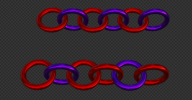
CCT takes this to mean that termination is attaching only a portion of the next cell. Termination can be applied to all weave forms, but weaves are themselves, never terminated.
Now, on to weave cells and weave patches, if we stick with root cells:
Unterminated and Terminated Chain forms require at least 2 connected unterminated cells (extension)

Unterminated and Terminated Sheet forms require at least 4 connected unterminated cells (extension & expansion)

Unterminated and Terminated 3D forms require at least 8 connected unterminated cells (extension, expansion, & elevation)

Hope that helps some more
Edited to add: In regards to sheets, the two unterminated sides should be adjacent.
Last edited:
Unfortunately this was not the process I followed. I started with a single BtW chain, then I added set of the yellow/orange rings and terminated that set of yellow/orange rings with red rings. I will try to make it again to make the position of rings on top of each other more consistent but to also make more about it clear.
Thank you this was very helpful. I will keep this guide in mind when working on redoing the item and taking more helpful pictures.That actually depends on us figuring out which configuration is being repeatedI think I need to go into a little more depth regarding translations and terminations. I am going to use Japanese 2 in 1 to show you though, LOL.
I see how this lines up with the image you created, however that does not reflect the processed that I followed to create the item.
The process I followed to create it was that I first created the red BtW chain then added the blue onto that, then added the green onto the result. Though, I am not sure if this changes anything.
Though I like the following image you made and I want to make something like it:
That's what will get me in troubleI see how this lines up with the image you created, however that does not reflect the processed that I followed to create the item.

The way you have this connected, no mater what process was used, you now have a red BtW and a green BtW. The ring that you have marked blue (that I additionally marked with a green dot) is now a part of the green BtW. The remaining blue rings are just tethering the two BtW bands together into one larger band. If red to blue to green is the direction we're expanding, then a representation of the weave itself would just be red and blue (minus the blue ring that I additionally marked) as the red is the base element and the blue is the tethering element. The green is the termination element of your band.
If the ring that I marked with the green dot were to be under the other green ring that is angled down on the right side of the band, then the green would be necessary in the representation as it would then be a reflective/mirrored band (#2).
A sheet representation would have to have a second set of blue rings added to the green as they are what make the representation directly translational.
#4 is what I'm talking about when I say "sympathetic". You're not starting from a terminated BtW band, but an unterminated one. This is done by taking away the termination element from a basic BtW band then connecting at least 2 of these together, the connections create what you see when you look at a terminated band. You would of course then terminate the weave to get a finished band of however many elements you would like like.
You can even do other things to the basic BtW band to give it a different look such as flipping it. and then that can be brought into the expansions.

Ok, this makes sense. Sorry for getting stuck on an immaterial portion of it.That's what will get me in troubleIMO, and therefore CCT, the process used to create the item is immaterial. It's the configuration of the final item where we figure out the structure.
Thank you for the clarification. I will take this into account and consider the current item to be a first iteration and try this again(I just need to find time to work on remaking it.)The way you have this connected, no mater what process was used, you now have a red BtW and a green BtW. The ring that you have marked blue (that I additionally marked with a green dot) is now a part of the green BtW. The remaining blue rings are just tethering the two BtW bands together into one larger band. If red to blue to green is the direction we're expanding, then a representation of the weave itself would just be red and blue (minus the blue ring that I additionally marked) as the red is the base element and the blue is the tethering element. The green is the termination element of your band.
If the ring that I marked with the green dot were to be under the other green ring that is angled down on the right side of the band, then the green would be necessary in the representation as it would then be a reflective/mirrored band (#2).
A sheet representation would have to have a second set of blue rings added to the green as they are what make the representation directly translational.
#4 is what I'm talking about when I say "sympathetic". You're not starting from a terminated BtW band, but an unterminated one. This is done by taking away the termination element from a basic BtW band then connecting at least 2 of these together, the connections create what you see when you look at a terminated band. You would of course then terminate the weave to get a finished band of however many elements you would like like.
You can even do other things to the basic BtW band to give it a different look such as flipping it. and then that can be brought into the expansions.




